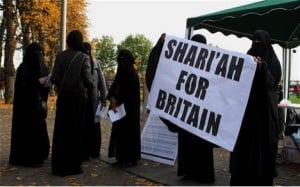I’ve been doing some research lately on spaces where “Muslim” and “Canadian” are talked about as if the two identities are completely separate, so of course I rolled my eyes when I saw the headline about “American and Muslim Women Working Together” from an article on Media For Freedom. (As it turns out, the article was originally published in 2005 by Common Ground News Service.) The author, Hiam Nawas, is described as “a Jordanian-American expert on political Islam.”
The article makes the important point that attempts by mainstream women’s organisations in the U.S. to try to support women in Muslim countries are often misguided and therefore not welcomed by Muslim women. Nawas argues that “American women need to understand that what is best for them is not necessarily what is best for Muslim women.” The second half of her article looks at some changes that need to happen in the way that issues facing women in Muslim countries are understood.
Some of the article’s points were okay, and I liked the emphasis that not all women are the same or have the same needs (she even made a point of illustrating the diversity among Muslim countries, which often doesn’t happen). But it drives me crazy when I see “American women” and “Muslim women” talked about as if they’re mutually exclusive categories. Perhaps it seems obvious that we should be understanding this as “[non-Muslim] American women” and “[non-American] Muslim women,” but I do think that this language is important, and that it’s a serious problem if the many women who identity both as American and as Muslim end up excluded from these discussions. For non-Muslim Americans (or for non-American Muslims) reading it, it could reinforce the idea of “American” identity as inherently non-Muslim, and of “Muslim” identity as inherently foreign to the United States. There are likely other assumptions being made about the category of “American” that exclude many other Americans for various other reasons.
Although Nawas finally acknowledges the presence of American Muslim women at the end of her article, the language used throughout the rest of the piece makes a more lasting statement. This quick mention of American Muslims therefore seems almost token-istic, and she refers to them as a group that “American women’s organisations” should work to include, rather than as Americans who may themselves already be organised and active in a whole variety of ways.
The article further positions “Muslim” women as always the ones who might need help from “American” women, and assumes that there is a need for “American” women to help if they do it in certain ways, which is also debatable. While she acknowledges that, for example “many women served in high-level government positions when Saddam Hussein was in power” in Iraq, and that Indonesians even elected a woman as president, there is still an assumption throughout the piece that “Muslim” women are in need of help and that there is a place for “American” women’s organisation to provide that help. In reality, I would argue that all of the countries that she mentions–the United States included–contain a wide diversity of class backgrounds, and ethnic and racialised groups, all of which shape the experiences of the people who live there, and their realities are far more complex than the “American” or “Muslim” narratives that Nawas describes.











